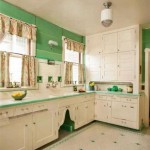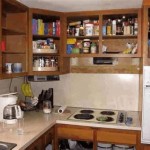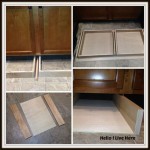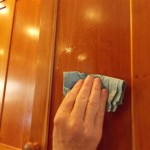DIY Crown Molding for Kitchen Cabinets: Elevate Your Kitchen's Style
Crown molding, the decorative trim that adorns the top of cabinetry, walls, and ceilings, can instantly elevate the visual appeal of any space. In kitchens, specifically, crown molding can add a touch of sophistication and elegance, creating a more polished and finished look. While professional installation is an option, tackling this project yourself can be a rewarding experience, allowing you to personalize your kitchen and potentially save money.
This guide provides a comprehensive overview of the DIY process for installing crown molding on kitchen cabinets, offering step-by-step instructions and helpful tips for a successful outcome. Whether you're a seasoned DIYer or a novice looking to enhance your kitchen's aesthetics, this guide will equip you with the knowledge and confidence to complete the project.
1. Material Selection and Preparation
The first step in your DIY crown molding project is choosing the right materials and ensuring proper preparation. This includes selecting the molding itself, gathering necessary tools, and preparing the surfaces where the molding will be installed.
Choosing the Right Molding
Crown molding comes in a wide range of styles, sizes, and materials. The best choice for your kitchen will depend on your personal preferences, the style of your cabinets, and the overall aesthetic you are aiming to achieve. Popular options include:
- MDF (Medium Density Fiberboard): Affordable and easy to work with, MDF crown molding is often a good choice for DIY projects. However, it is susceptible to moisture and may require sealing to prevent warping or damage.
- Wood: For a more traditional and natural look, consider wood crown molding. While it can be more expensive, it offers durability and a timeless appeal. Popular wood options include pine, oak, and maple.
- PVC (Polyvinyl Chloride): PVC crown molding is moisture-resistant, making it ideal for kitchens and bathrooms. It is also highly durable and available in various styles.
Tools and Supplies
To install crown molding successfully, you'll need the following tools and supplies:
- Miter saw or chop saw: For precise cuts at various angles.
- Measuring tape: For accurate measurements.
- Level: To ensure the molding is installed straight and level.
- Pencil: For marking cuts and installation lines.
- Nail gun or hammer and nails: To secure the molding to the cabinets.
- Caulk gun and caulk: To fill gaps and seal the molding.
- Wood filler: To fill any nail holes or imperfections.
- Sandpaper: To smooth out rough edges and prepare surfaces for painting.
- Primer and paint: To create a smooth finish and match the existing cabinetry.
Surface Preparation
Before starting installation, ensure the surfaces are clean and ready for the crown molding. This involves:
- Cleaning: Thoroughly clean the top of the cabinets and the wall where the molding will be installed. Remove any dust, debris, or grease.
- Filling Gaps: Use wood filler to fill any gaps or imperfections on the cabinet surface. Allow the filler to dry completely before sanding.
- Sanding: Lightly sand the surfaces to remove any dust, debris, or unevenness. This will ensure a smooth and even installation.
2. Cutting and Measuring the Crown Molding
Accurate cutting and measuring are crucial for a professional-looking installation. This step involves determining the length and angles of the molding pieces and making precise cuts with your miter saw.
Determining Lengths
Measure the length of each section of crown molding needed to cover the entire cabinet run. Ensure the measurements are accurate, as any errors will be noticeable in the final installation.
Cutting the Molding
Use your miter saw to make precise cuts at the appropriate angles for each section of molding. Depending on the style of your crown molding and the shape of your cabinets, you may need to make 45-degree miter cuts or 90-degree cuts. Consult a guide or video for specific instructions based on your molding style.
Mock Installation
Before attaching the molding permanently, it's always a good idea to do a mock installation. This involves dry fitting the pieces together to ensure they fit perfectly and to make any necessary adjustments to the cuts.
3. Installing the Crown Molding
With the pieces cut and the surfaces prepared, you're ready to install the crown molding. This step involves securing the molding in place, filling gaps, and ensuring a neat and professional look.
Securing the Molding
Begin by attaching the molding to the cabinet using a nail gun or hammer and nails. Start at one end of the cabinet run and work your way across.
Filling Gaps and Finishing
After securing the molding, use caulk to fill any gaps between the molding and the cabinets or wall. Allow the caulk to dry completely before sanding and painting.
Painting
Prime and paint the crown molding to match the existing cabinets. Allow the paint to dry completely before removing any masking tape or protective coverings.

Diy Kitchen Cabinet Upgrade With Paint And Crown Molding

Adding Crown Molding To Kitchen Cabinets Young House Love

Diy Kitchen Cabinet Upgrade With Paint And Crown Molding

Diy Kitchen Cabinet Upgrade With Paint And Crown Molding

How To Add Crown Molding Kitchen Cabinets Abby Organizes

Cabinet Crown Molding Rogue Engineer

How To Add Crown Molding Kitchen Cabinets Abby Organizes

Diy Kitchen Cabinet Upgrade With Paint And Crown Molding

Adding Moldings To Your Kitchen Cabinets Remodelando La Casa

Adding Height To The Kitchen Cabinets Tempting Thyme
Related Posts








